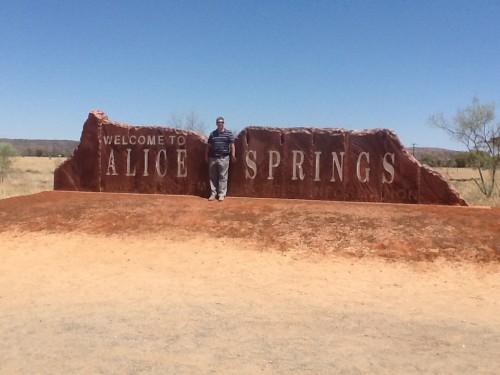14th December 2014
A Town Like Alice
“The Alice”, Alice Springs – the very name evokes our image of the “real” Australia. In fact the average Australian lives in a suburb in Sydney or Melbourne: it’s one of the most urbanized societies in the world. But the Outback certainly lives up to its image: searing heat, deep red ochre soil, and vast distances.
I was visiting Peter Saville, our Honorary Consul in the Alice: I had already made official visits to all of our other Hon Cons around Australia. Peter assists British nationals who run into difficulties, from helping with tragic accidents to signposting where to go if you lose your passport. Brits and Germans are the two largest groups of foreign tourists in the Northern Territory, both around 35,000 a year, and UK visitors are up 6% this year. Nearly half of them are in the 15-29 age group; many of these are “working holiday makers” on one-year visas, who supplement their travel by working in local hotels and restaurants.
I did the usual round of official calls, meeting Mayor Damien Ryan and Deputy Northern Territory Administrator Pat Miller. We had dinner with local MP Warren Snowden and his wife (I ate crocodile and camel): I had got to know him well when he was a defence Minister in the previous federal administration. Everyone was understandably enthusiastic about their unique city in the “Red Centre”.
I also had the chance to visit a number of iconic Australian institutions that play distinctive roles because of Alice Springs’ unique geography.
- The famous Royal Flying Doctors, which since 1928 has been operating planes helping hundreds of thousands of people across a vast area, delivering medical care and responding to emergencies.
- The School of the Air provides an education for children living in remote communities and on cattle stations. It used to work via the radio, as I recall from watching Skippy as a kid, but the service has been transformed over the last decade by the arrival of the internet. I chatted onscreen to one 13 year old living on a 12,500 km2 property (that’s over 3 million acres), whose nearest neighbours were 5 hours drive away.
- The Ngaanyatjarra Pitjantjatjara Yankunytjatjara Women’s Council supports women and girls scattered across some 80 remote indigenous settlements, providing a range of social services as well as promoting the famous “desert weavers” arts project.
Hon Con Peter’s day job is as a veterinarian, working mainly with beef cattle. He took us to a test station, where they are experimenting with different breeds of cattle, and finding ways to use technology to help the farmers run properties the size of countries. Apparently the “Jackeroos” (Australian cowboys) are as likely to be using helicopters and quad bikes as horses nowadays; and unmanned drones offer new possibilities for the future.
Alice is certainly a bit of a wonderland.

Glad you got there, and that you made contact with the Ngaanyatjarra Pitjantjatjara Yankunytjatjara Women’s Council.
What really matters when it comes to health & education in the NT remote areas these days though, is not so much the RFDS or School of the Air. It is the quality and extent of support provided to Indigenous Health Services and to ensuring experienced , teachers, competent in local languages, are working in the remote area community schools. Sadly, in both these critical areas, things are now going backwards .
Instead we have governments obsessed with “income management” and forcing Aboriginal kids to learn in a language which is not their mother tongue. In so doing they ignore all of the research, and all of the lessons learned in 200 yrs of failed policy. Utter madness.